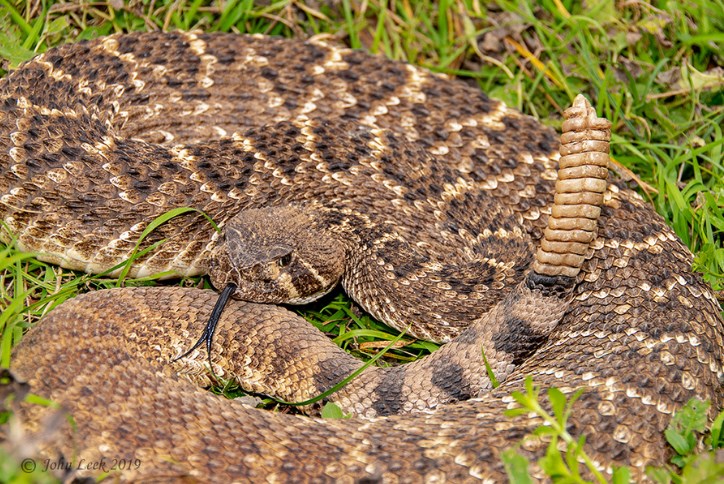
24 March . 2021
What do to when you see a snake
Of all the resident events held throughout the year at Sweetwater, some of the most popular are the Texas Snake Education classes hosted by Austin Reptile Service. Past classes have been held at the Sweetwater Club. For 2020, the class was held on Zoom, as were many other Sweetwater events in the interest of social distancing.
“Kids especially are fascinated by the snakes,” says Shelly Livingston, Sweetwater’s Lifestyle Coordinator.
Tim Cole, owner of Austin Reptile Service, agrees. “Unless they’ve been taught to fear snakes, kids have a natural curiosity,” he says.
Since spring is a very active time for snakes, we checked in with Cole to get some tips on how to identify them and what to do if you see one.
The bottom line is that most snakes are not only harmless, but beneficial, Cole says. Snakes are more afraid of us than we are of them, and they just want to be left alone. About the only time a human gets bit by a snake is when they fail to observe the snake’s warning signs and invade its space, forcing a reaction.
Camouflage is the main way that snakes protect themselves, and rattlesnakes especially rely heavily on blending in. If they sense danger, the most common response is to take flight, but they will fight as a last resort.
“Snakes are never aggressive toward people, only defensive,” Cole says. “A snake will let you know when it’s afraid, by coiling up or shaking its tail. A snake’s tail wagging is the opposite of a dog. It means, ‘go away.’”
Many kinds of snakes will shake their tail as a warning, not just rattlesnakes. Sometimes the tail shaking can produce a noise that people can mistake for a rattlesnake, especially when it hits against dry leaves or other objects. That’s why it’s so important to know the basics of snake identification.
How to tell the harmless Rat Snake from a Rattlesnake
The harmless Texas Rat Snake is the most common snake in Austin, and it’s often mistaken for a rattlesnake.
“If I get 20 calls to come and remove a rattlesnake, 19 of those times, the snake actually turns out to be a Rat Snake,” Cole says.
To make a quick identification, look for the rattle. Rattlesnakes have an actual rattle, while Rat Snakes do not, despite the rattle-like movement or noise they may make.
Also look at the snake’s skin. Rat Snakes have a background color that is red, yellow, orange, or a combination of these colors. On top of the background, Rat Snakes have a patterning of black blotches.
The Western Diamondback Rattlesnake, the type of rattlesnake most commonly seen in the Austin area, has a diamond pattern with mostly brown and gray coloring, along with a small amount of white.
Rat Snakes are excellent climbers, so you may seem them scaling trees, walls and other vertical surfaces. Rattlesnakes are not good climbers, so it’s unlikely to see one off of the ground.
What to do when you see a snake
Snake activity is seasonal, and spring is the most active season in the Austin area. In spring, snakes emerge from winter inactivity, hungry and ready to find breeding mates. Once summer approaches and daytime temperatures begin to hit 90 degrees and higher, snakes take refuge in the daytime and conduct most of their activity at night. They resume increased daytime activity in the fall.
If you see a snake while out enjoying the trails in Sweetwater or elsewhere in the Austin area, Cole’s best advice is to simply give the snake a wide berth.
Sometimes snakes will lie in the middle of the trail for warmth, especially if it’s a paved trail. The snake could also be waiting for prey it has detected nearby. If you can’t go around a snake lying on a trail, the best action may to be reverse your course.
If you see a snake in your yard and want to chase it away, Cole advises spraying it with the hose.
“It’s very easy to train a snake. They will never return to the exact location where they have had a negative interaction with a human, but they will stay in the area, providing a very valuable service of keeping the rodent population down,” he says.
Keeping beneficial snakes such as rat snakes and garter snakes around will also help prevent rattlesnakes from entering the area, since they compete with them for the same food sources.
“Snakes provide us with some very valuable services, like rodent control, at no charge to us,” Cole says.
In addition to his snake parties at Sweetwater, Cole hosts educational events throughout the year for schools, scouting groups, birthday parties and other occasions.
A self-taught reptile expert, Cole moved to Austin from Northern Illinois in search of snakes and heat. He was not disappointed by Texas’ supply of either.
“Texas has a lot more diversity in its snake species than Illinois,” he said. “My passion has always been to dispel all the urban myths and misconceptions about snakes and other reptiles, and to promote conservation through education.”
Photo credit: John Leek.